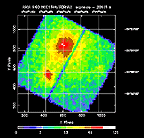X-ray Telescopes
How Do You Focus X-rays and Why Would You Want to Focus Them?
The first X-ray telescope used in astronomy was to observe the Sun,
the only X-ray source in the sky producing an abundance of measurable
signal.
The first X-ray picture of the Sun, by a rocket-borne telescope, was
taken in
1963. The first orbiting X-ray telescope flew on Skylab in the early
1970's
and recorded over 35,000 full-disk images of the Sun.
The utilization of X-ray mirrors for extra-solar X-ray astronomy had to
await two developments in electronic detectors:(1) the ability to
determine
the location of the arrival of an X-ray photon in two dimensions, and
(2)
simultaneously possessing a reasonable detection efficiency. Such
detectors
as the imaging proportional counter, the microchannel plate detector,
CCD
spectrometers, and imaging gas scintillation proportional counters have
been
developed to fit this need.
The design of an X-ray imaging system is difficult because of the
constraints imposed by the interaction of X-rays with matter. X-rays
impinging at normal incidence (that is, perpendicular) on any material
are
largely absorbed rather than reflected. Normal incidence mirrors, like
those
used for optical telescopes, are thus ruled out. For an X-ray telescope,
you
must select a material which reflects the X-ray photon (so that
the X-rays are not absorbed) and design your telescope so that the X-ray
photons hit the mirror at small, "grazing", incidence (so that
they
will be reflected). The most commonly used reflecting materials for
X-ray mirrors are gold (used in the
Suzaku,
XMM, and
Swift satellites)
and iridium (used by the
Chandra X-ray Observatory). For gold, the
critical reflection
angle at 1 keV is 3.72 degrees.

It was shown mathematically that a reflection off a parabolic mirror
followed by a reflection off a hyperbolic mirror could lead to the
focusing of X-rays. Several designs have been used in X-ray telescopes
based on this principle: the Kirkpatrick-Baez design and a couple of
designs by Wolter.

NGC1399 |
So why focus X-rays at all? Focusing helps create a clearer and
shaper image of the X-ray source. It also allows scientists to get a
better measure of faint X-ray sources which they could not otherwise
detect. Sharp images help scientists to understand the
distribution of hot gas between galaxies, the physics of supernova
remnant
expansion, and many other important issues. The ability to make an X-ray telescope moved
astronomy forward in a big leap; the creation of X-ray telescopes with
better spatial resolution and larger effective collection areas will
continue
to reveal exciting new information about the workings of our Universe.
|
Last Modified: July 2008
|
